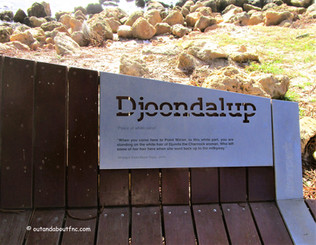Jenna Bidi Yorga - Blackwall Reach - Bicton
- Out and About

- Dec 24, 2022
- 4 min read
Updated: May 28

Jenna Bidi Yorga means “women’s feet walking on the path” in Whadjuk Noongar. This trail traverses the ancient lands of the Whadjuk Noongar people from Djoondalup (the Point Walter Sand spit) along Jenalup "the place where the feet make a track" (Blackwall Reach) to Kwoppa Kepa "beautiiful water" (Bicton Foreshore). It is a culturally significant trail which carries the Dreamtime story of Djuna the Charnock woman. Jenalup is traditionally a place for women and children to learn life skills, to catch fish in shallow waters, dig native yams from the riverbanks and collect fresh water from the limestone caves.
We started the trail from Point Walter where there are picnic and barbecue facilities, toilets, a cafe, a playground and lots of parking although this does fill on a warm sunny day as people head to the reserve to enjoy the cool shallow waters.
You can walk around the point or hike up the hill to the Habibi sculpture. The trail entrance is almost opposite the sculpture on Honour Avenue and is clearly marked with some degraded but still legible information panels at the entrance.
This trail has two parallel paths - the paved dual use path or the wider dirt trail which is slightly inland. Both trails offer similar limited water views through the bush and both provide access to the three viewing platforms.
We walked the paved path westbound and returned along the dirt trail. If you are walking with young kids or dogs the dirt trail may suit you better as you won't have to worry about cyclists coming up behind. The trail is quite hilly so some of the bikes are travelling quite fast and this can be a bit of a hazard.
The trail from Point Walter to where it emerges at Bicton Foreshore is about 1.3km long and will take about 20 - 30 minutes. Along the way you can access a little beach via some steps. This section had recently had a fire burn through but fortunately damage was only over a very small area.
Further along there are three gated access points to viewing platforms poised on the edge of the cliff. The platforms provide a close up look at the limestone rock formations as well as stunning views up and down the river!
We turned around at Bicton Foreshore where the trail meets the houses along Blackwall Reach Parade but not before stepping out onto the little river beach for more river views beyond Kent Street Jetty. On our return journey we veered off the paved path to follow the dirt trail.
From this point you could also continue along the dual use path running along Blackwell Reach Parade for another 1km through to Bicton Baths and the Bicton Quarantine Park which has picnic and barbecue facilities, toilets and a playground with limited parking. This takes the total walk to just over 2km in each direction.
We walked this trail in November so there wasn't much out in the way of wildflowers but there were still splashes of colour along the way.
Back at Point Walter you are now standing at Djoondalup, “place of the white hair”. Whadjuk Noongars used this area to cross from one side of the river to the other, walking on the sand spit - the hair of the Charnock Woman - and you can also walk along the sand spit. Where Whadjuk Noongars once built fish traps you can enjoy a swim or paddle a SUP board.
There are plenty of things to keep you busy at Point Walter Reserve so pack a picnic and enjoy a day on the river. Click on the link to find out more about Point Walter.
Download the Geotourist App and listen to Marie Taylor talk about the footprint of Djunda the Charnock Woman, a spirit woman who collected spirit children, keeping them in her strands of long white hair, and how the Waugyl, a powerful serpent-like creature formed these limestone rocks. You can also listen to Whadjuk Elder Noel Morich explain why the river was so important to Noongars.

To read more blogs go to:
I love wandering along trails, both marked and unmarked, and sharing my discoveries with my Out and About FNC community. If you enjoy reading my blogs please consider a small donation which will be used towards the costs of keeping the website up to date and relevant.

In the spirit of reconciliation Out and About- Family Nature Connection acknowledges the traditional owners of the Wadjak boodjar (Perth land) and their connections to land, sea and community. We pay our respect to their elders past and present and emerging and extend that respect to all Aboriginal and Torres Strait Islander peoples today.
As always when hiking in the bush please help to reduce the spread of Phytophthora Dieback by sticking to the tracks and paths, staying out of quarantined areas and, if possible, clean your shoes before and after hiking. A spray of 70% methylated spirit and 30% water can be effective.





























































Comments